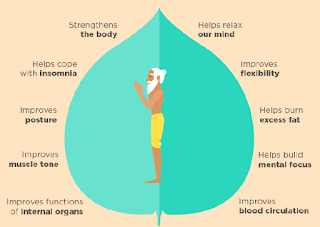Hatha Yoga - Traditional style of Yoga Asana
Hatha Yoga - Traditional form of Yoga
 |
| Surya Namaskar |
Hatha Yoga is said to be popularized by Yogi Matsyendranath, who also laid the foundation of 'Natha Sampradaya'(Natha Sect).
Matsyendranatha, also known as 'Macchindranath' or 'Minanath' is said to be born around the 10th century CE around Bengal(although there are diverse opinions about his place of birth). He is revered in both, Hinduism and Buddhism and is sometimes regarded as an incarnation of 'Avalokiteswara' (a Bodhisattva) in Buddhism.
There are many legends about Matsyendranath; most popular being the one which says, "Matsyendranath was born under inauspicious stars. This warranted his parents to throw the baby into the ocean. It was there that the baby was swallowed by a fish. The fish swam to the bottom of the ocean where Shiva was imparting the secrets of yoga to his consort, Goddess Parvati. Upon overhearing the secrets of yoga, Matsyendranath began to practice Yoga-Sadhana inside the fish's belly. After twelve years he finally emerged as an enlightened Siddha(perfected one). This is often given as the origin of his name 'Lord of the Fishes' or 'He Whose Lord is the Lord of the Fishes'(Matsya: Fish, Nath: Lord). "
The most influential surviving Hath Yoga text is 'Hatha Yoga Pradikpika'(meaning, light on Hatha Yoga) written in 15th century CE by Swami Svatmarama.
It enlists 35 great Yoga Siddhas starting with Adi Natha (Lord Shiva) followed by Matsyendranath and Gorakshanath( disciple of Matsyendranath). It includes information about Shatkarma (six acts of self purification), 15 asana (postures: seated, laying down, and non-seated), Pranayama (breathing) and Kumbhaka (breath retention), Mudras (internalized energetic practices), Meditation, Chakras (centers of energy), Kundalini, Nada-anusandhana (concentration on inner sound), and other topics.
It consists of 389 shlokas (verses) in four chapters.
The most influential surviving Hath Yoga text is 'Hatha Yoga Pradikpika'(meaning, light on Hatha Yoga) written in 15th century CE by Swami Svatmarama.
It enlists 35 great Yoga Siddhas starting with Adi Natha (Lord Shiva) followed by Matsyendranath and Gorakshanath( disciple of Matsyendranath). It includes information about Shatkarma (six acts of self purification), 15 asana (postures: seated, laying down, and non-seated), Pranayama (breathing) and Kumbhaka (breath retention), Mudras (internalized energetic practices), Meditation, Chakras (centers of energy), Kundalini, Nada-anusandhana (concentration on inner sound), and other topics.
It consists of 389 shlokas (verses) in four chapters.
Hatha Yoga became popular among masses as it eliminated the need for ascetic renunciation or other ritualistic paraphernalia. It could be practiced by anyone irrespective of their sex, caste, creed or class.
But derision started growing day-by-day towards Yogis during foreign occupancy.
It was due to efforts of likes of Swami Vivekananda, Yoga could be preserved.
Modern Yoga, of the type seen in the West, has been greatly influenced by the school of Tirumalai Krishnamacharya, who taught from 1924 until his death in 1989. He combined asanas from Hatha Yoga with gymnastic exercises from the physical culture of the time, to develop a flowing style of physical yoga that placed little or no emphasis on Hatha Yoga's spiritual goal.
Today there are different types of yoga being followed that make use of Hatha yoga. Example: Anusara Yoga, Ashtanga Vinyasa Yoga, Integral Yoga, Iyengar Yoga, Jivamukti Yoga, Kundalini Yoga, Kripalu Yoga etc.
In Western culture, Hatha Yoga is typically understood as asanas (postures) and it can be practiced as such.
But in Indian and Tibetan traditions, Hatha Yoga is much more. It extends well beyond being a sophisticated physical exercise system and integrates ideas of ethics, proper diet, proper cleansing, Pranayama (breathing exercises), meditation and a system for the spiritual development of the yogi.


Comments
Post a Comment